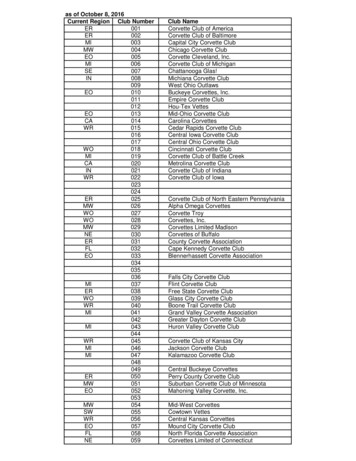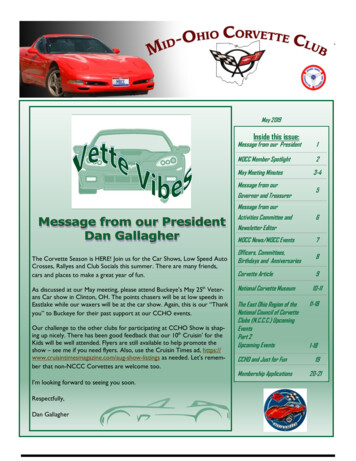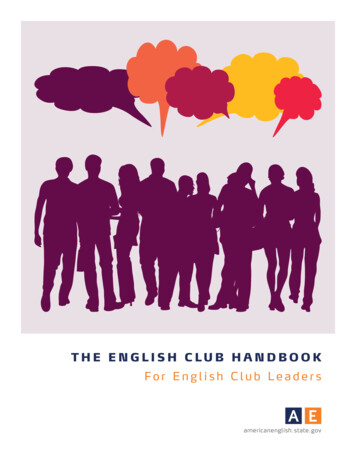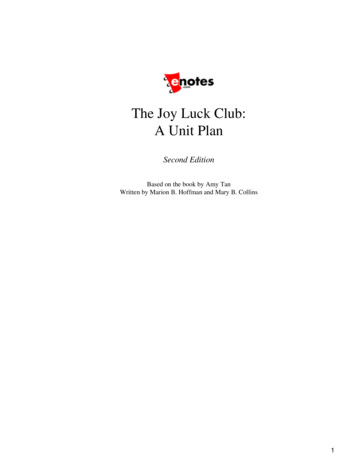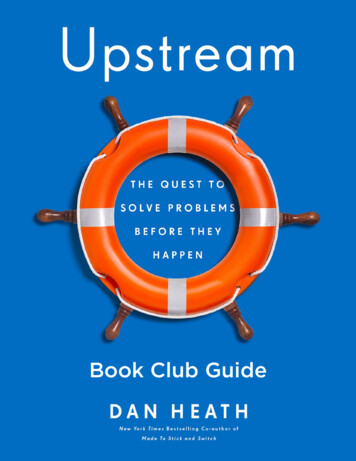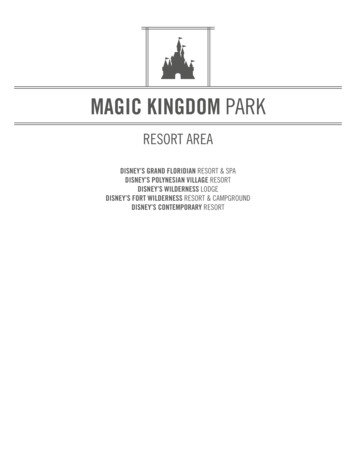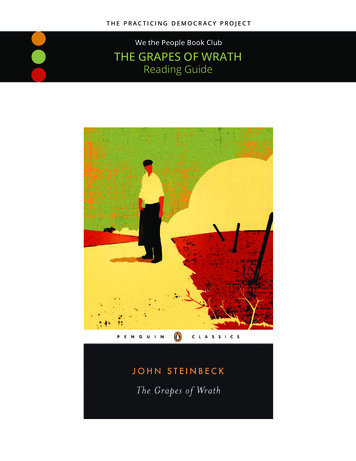
Transcription
THE PRACTICING DEMOCRACY PROJECTWe the People Book ClubTHE GRAPES OF WRATHReading Guide
THE GRAPES OF WRATH is the ideal selection to inaugurate the We thePeople Book Club: it is equally about democracy and spirituality. In fact, asJohn Steinbeck explores them in this novel, the soul and a democracy are madeof the same stuff: people working together, recognizing themselves in one another,and treating that interdependence as a “sacred honor.”With The Grapes of Wrath, published in 1939, John Steinbeck used fiction to intervenein one of the twentieth century’s worst environmental, economic, and social crises.With urgency and insight, he captured the plight of the “Okies,” refugees from theDust Bowl and capitalism run amuck. The novel has become an American classic,taught in classrooms from junior high to college as essential reading for anyoneinterested in exploring themes that run deep not only in American literature butAmerican life.The Grapes of Wrath received the National Book Award for Fiction and a Pulitzer Prizefor Fiction in 1940; it was cited when John Steinbeck received the Nobel Prize forLiterature in 1962.About This Book Club Reading GuideThis guide was researched and written by Julia Davis, a 2018 - 2019 PracticingDemocracy Fellow. It includes background on how Steinbeck came to write The Grapesof Wrath, an overview of the story, and observations on the literary structure of thenovel. For your personal exploration and/or discussion with others in your book club,we include commentary on three themes. Questions within each will facilitate threeapproaches to the work: (1) your interpretation of the text, (2) your personalreflections inspired by your reading, and (3) practices for you to try that animate thenovel’s democratic values. The guide also includes ideas for further exploration; youmight decide to engage these resources before or after your discussion.BackgroundAfter years of research, study, and first-hand experience, John Steinbeck wroteThe Grapes of Wrath in a 100-day burst of creative energy. In the years leading upto the writing and publication, Steinbeck lived and worked among the migrants inCalifornia, befriended Tom Collins (the camp manager to whom the book is in partdedicated), and advocated for the workers by writing newspaper and magazinearticles. He was determined to make visible the ways in which the migrants wereabused and dehumanized by the powerful monied interests of the California farmingestablishment. The book was published in 1939 and immediately banned — and evenburned — in many California cities.THE GRAPES OF WRATH We the People Book Club2
OverviewThe Grapes of Wrath tells the story of the Joad family, forced off their land in Oklahomaafter the Dust Bowl made sharecropping not just a debtors’ game but a losingproposition. At the same time, the invention of the tractor, far more efficient thanthe human body, allowed land companies and their banks to make a bigger profit offof the land by amassing it into large holdings. This technological change left farmingfamilies like the Joads dispossessed, bullied, and scrambling to survive.As the novel begins, Tom Joad is headed home from a stint in prison for killing a manin self-defense. When he returns to the family farm, he finds his folks packing forCalifornia, having seen handbills advertising jobs picking fruit. They join thousandsof other migrants going west through Oklahoma, Texas, New Mexico, and Arizonaon Route 66, everyone hopeful for new life in California. After crossing a punishingdesert, the Joads behold the verdant orchards and fields of California. However,elation turns quickly to worry and more hardship than they left behind them as theyrealize that all of this beautiful land, even the fallow acres, is owned, work is scarce,and migrants are unwanted, hated, and exploited. The Joads work hard where theyfind a wage, create community with their fellow migrants, and persevere through themonumental changes and challenges taking hold of the world they once knew.Meanwhile, the preacher Jim Casy and Tom, who becomes a sort of prophet-hero,listen carefully to the people, study the great change, and give themselves overcompletely to what is now the most crucial work in sustaining democracy: labororganizing.Genre, Language, and StructureThe Grapes of Wrath was essentially an act of journalistic advocacy: it supportedmigrants’ rights in a national crisis that had hardly resolved. And yet for a novel“ripped from the headlines” and full of detail influenced by camp manager TomCollins’ weekly reports from the 1930s, The Grapes of Wrath has maintained relevanceboth as a text about American democracy and as a text about the human condition.This is in part due to Steinbeck’s language, which draws out of the materiality of thehere and now the spirituality of transcendent truth.The novel’s lasting relevance and beauty are also due to Steinbeck’s structure: healternates between narrative chapters about the Joads’ journey and “interchapters”that offer a wider historical context and more concentrated theme development.The interchapters often foreshadow an event in the novelistic chapters; this techniqueallows Steinbeck to focus on the Joads’ story and suggest that the Joads’ experiencesare representative. In this way, structure mirrors theme: The particular is but part ofthe universal.THE GRAPES OF WRATH We the People Book Club3
ThemesThe Necessity of ConnectionThis theme suffuses The Grapes of Wrath from beginning to end — connection tothe land and the fruits of labor, to one another and the universal soul. This is Grapes’great warning, that when alienation replaces connection and exploitation trumpsrelationship, everyone loses. We lose the feeling of the earth sifting through ourhands, the feeling of dignity from honest work, the feeling of another’s pain, andthe feeling that we are more than matter.The Joads’ greatest antagonists are not hunger, thirst, weather, and the law; they areself-interest, ownership, greed, and fear of strangers. The story of the Joads is a storyof a family that confronts these antagonists and chooses connection: they open theirfamily unit to the Wilsons and to hungry kids other than Ruthie and Winfield; Casybegins by theorizing about the universal soul and ends by putting this spiritual beliefinto practice as a union organizer, with Tom following in his footsteps; and, finally,Rose of Sharon dramatically crosses the boundaries of family, sexuality, age, privacy,and her own grief to give the milk of life to a dying stranger.THINK1. Consider the pair of passages below about the universal soul, holiness andorganizing, and bring in other quotes relating to the necessity of connection as theycome to the group. They are from chapter 7 and chapter 28, respectively.“ ‘An’ I got thinkin’, on’y it wasn’t thinkin, it was deeper down than thinkin’. I got thinkin’how we was holy when we was one thing, an’ mankin’ was holy when it was one thing.THE GRAPES OF WRATH We the People Book Club4
An’ it on’y got unholy when one mis’able little fella got the bit in his teeth an’ runoff his own way, kickin’ an’ draggin’ an’ fightin’. Fella like that bust the holiness. Butwhen they’re all workin’ together, not one fella for another fella, but one fella kind ofharnessed to the whole shebang—that’s right, that’s holy. An’ then I got thinkin’ I don’teven know what I mean by holy.’ ”“Tom laughed uneasily, ‘Well, maybe like Casy says, a fella ain’t got a soul of his own,but on’y a piece of a big one — an’ then —’“ ‘Then what, Tom?’“ ‘Then it don’ matter. Then I’ll be all aroun’ in the dark. I’ll be ever’where — whereveryou look. Wherever they’s a fight so hungry people can eat, I’ll be there. Whereverthey’s a cop beatin’ up a guy, I’ll be there. If Casy knowed, why, I’ll be in the way guysyell when they’re mad an’ — I’ll be in the way kids laugh when they’re hungry an’ theyknow supper’s ready. An’ when our folks eat the stuff they raise an’ live in the housesthey build — why, I’ll be there. See? God, I’m talkin’ like Casy. Comes of thinkin’ abouthim so much. Seems like I can see him sometimes.’ ”How do you understand Casy’s ideas about wholeness and holiness? Based on thisview, what is holy in the novel?Were you surprised Tom did not reappear in the novel? Why do you think Steinbeckmade these words Tom’s last and did not write him into the ending of the novel?What does Tom mean when he says “I’ll be there”?Casy is adamant about not being a preacher anymore, but sometimes slips intowhat seems to him like a sermon. What are some ways to understand Casy’stransformation from preacher to activist/union organizer?REFLECT2. Consider this passage from the last chapter: “For a minute Rose of Sharon sat stillin the whispering barn. Then she hoisted her body up and drew the comfort abouther. She moved slowly to the corner and stood looking down at the wasted face, intothe wide, frightened eyes. He shook his head slowly from side to side. Rose of Sharonloosened one side of the blanket and bared her breast. ‘You got to,’ she said. Shesquirmed closer and pulled his head close. ‘There!’ she said. ‘There.’ Her hand movedbehind his head and supported it. Her fingers moved gently in his hair. She looked upand across the barn, and her lips came together and smiled mysteriously.”Rose of Sharon crosses many divides to connect with another human. She baresherself to a stranger, an elder, a man. Steinbeck presents this gesture like a beautifulpainting and ends his novel there, with many questions unanswered. One of thequestions the ending inspires is this: What are the differences that really test yourcommitment to life, to community and unity? What divisions seem utterly naturalto you? Under what circumstances might you be willing to cross those divides in theservice of life and connection? Perhaps you have crossed them before. Share thatstory with the group.THE GRAPES OF WRATH We the People Book Club5
PRACTICE3. Tom Collins was a camp manager tasked with setting up each new migrant campin California. A genius social worker, Collins understood the dehumanization themigrants had endured and believed that participating in representative democracy —being heard and useful — could help to restore the migrants’ dignity. His managerialphilosophy was to let the people lead; he was beloved for it, and it worked.His real-life models of democracy were the basis for Steinbeck’s representation ofthe government camp in chapter 22, an oasis of democratic cooperation in a seaof exploitation and fear. The health and order within the camp are testament towhat folks can do together when they feel connected to one another, to a commonpurpose, and to the land.Upon arrival at the camp, Tom is astounded to hear the manager talk about thecamp’s self-government, which is local, representative, and independent from thecorrupt local authorities: “ ‘You mean to say the fellas that runs the camp is jus’ fellas— campin’ here?’ ” The camp manager replies, ‘Sure. And it works.’ ”Think about the many small communities you belong to — families, offices, churches,service clubs, professional organizations, etc. Commit to surveying the members ofthese communities and finding out who feels disconnected, unheard, or invisible.Have a conversation with them. Talk with them about how this community couldbe more democratic. Perhaps authority seems concentrated, leading to silence andpassivity. Perhaps the community seems too large, leading to anonymity and apathy.Then start a larger conversation within the community to clarify that organizationsof all kinds work better when everyone has responsibility, accountability, voice,and opportunity.Technological ChangeTechnological changes antiquate the Joads’ way of making a living and constructingmeaning. For them, intimacy with the land is life itself. The land feeds the family andgives them spiritual food, sustaining a sense of purpose. Knowing the soil and caringfor the land correspond with knowing and caring for loved ones. The Joads read theirfamily’s history and identity in the acreage they’ve farmed for generations.The tractor and the bank, Steinbeck’s two “monsters,” change all of that. Land ismachined not handled. Crops are profits not food. Drought, rain, and harvest arespreadsheet columns. And the Joads are forcibly separated from all of it — the landitself, the fruits of it, and the new system of meaning.With new technology come new social relations, specifically family structure andgender roles. Pa Joad loses his place when the family loses land and work; thesesources of authority are replaced by the car, driven by Al, and the tent, governedby Ma. As the novel and the journey progress, Ma makes the decisions, keeping thefamily together and tending to its emotional needs.The great changes work on a grander scale as well. They make the generationaldivides more significant: Grandpa dies away from the land, heartbroken, while thechildren, Ruthie and Winfield, embrace adaptation as an adventure.THE GRAPES OF WRATH We the People Book Club6
Most importantly for Steinbeck, technological change widens the gap between ownersand wage laborers; this gap is not just economic but spiritual. The great innovation,the tractor, renders the Joads and the owners more vulnerable, the Joads in a materialsense and the owners in a spiritual sense. Steinbeck is at pains to point out that, whilethe owners have gained monetarily in the short-term, they have invested in loss andwill accrue in kind. Alienated from the preciousness and holiness of life itself and whatgives it, they spoil oranges with kerosene, drown potatoes, and bury pigs.The social separation between wage-earners and owners traps the owners inI and mine and draws the laborers into the we and ours of a counter-revolution,which begins with unionizing. While Steinbeck did not identify as a socialist, he feltsomething coming based on the patterns of history: the owners’ revolution sewingthe seeds of the peoples’: Food destroyed to preserve profit grows the grapes ofwrath “heavy for the vintage.”THINK1. Consider this passage from chapter 21: “There in the Middle and Southwest hadlived a simple agrarian folk who had not changed with industry, who had not farmedwith machines or known the power and danger of machines in private hands. Theyhad not grown up in the paradoxes of industry. Their senses were still sharp to theridiculousness of the industrial life.”What does Steinbeck mean by the “paradoxes of industry” and “the ridiculousness ofindustrial life?”Critics have accused Steinbeck of romanticizing the Joads as these “simple agrarianfolk.” Were there moments in the novel that made you feel this way? Do you thinkSteinbeck oversimplifies a complex set of historical forces as he sets the Joads up asTHE GRAPES OF WRATH We the People Book Club7
heroes and sets the owners up as antagonists? How so? And if so, does this make thenovel more or less successful? What was Steinbeck trying to achieve?REFLECT2. Technological changes can shape our relationships and shift our sense of security.As you discuss these questions, keep in mind the various levels at which technologicalchange can impact us: personal, familial, communal, professional, national, etc.Think about the technological changes that occurred while you were growing up, onesstrong enough to create a vivid sense of “before” and “after.” How did those changesimpact you?Now think about the technological changes that have occurred later in your life,perhaps after the onset of adulthood and midlife. How is the quality of “before” and“after” different once you have more years behind you? What color is “before” in yourmind? What color is “after”?If it has not come up already, concentrate discussion on the impact of social mediaand smartphones. How have these innovations changed your relationships with yourfamily, friends, co-workers, and neighbors? How have they changed your relationshipto yourself?As a group, reflect how differences in age, experience, and socioeconomicstatus influence your varying reactions to technological change (vulnerability,adaptation, power).PRACTICE3. Consider this passage from chapter 25: “The decay spreads over the State, and thesweet smell is a great sorrow on the land. Men who can graft the trees and make theseed fertile and big can find no way to let the hungry people eat their produce. Menwho have created new fruits in the world cannot create a system whereby their fruitsmay be eaten. And the failure hangs over the state like a great sorrow.”The word “can” in this passage is not about ability but rather about the artificial limitsplaced on what’s possible by systems that we either expressly or tacitly agree to. Oneof these systems is capitalism, which makes profit a rule, even though profit is not a“natural rule,” that is, not a rule that actually governs what is possible. Sometimes, inorder to serve the common good, it is necessary to release our thoughts and actionsfrom the limits of these systems. This is easier said than done. It will take practice.Begin by identifying a limit — in some system of government, economics, religion, etc.— that you live by that does not serve the common good. Perhaps it was designed to,but in reality does not. Perhaps it provides you security but does not align with yourown sense of values. Speak about that limit with the group.As a We the People Book Club, you are a nucleus of incremental change. Imagine howyou might revise a system so that it meets a common need. (Some might think ofthis as a “hack.”) Innovate a way to redirect power and resources away from the few’sdesire or convenience and towards the many’s necessities. Commit to an achievablegoal and report at the next meeting.THE GRAPES OF WRATH We the People Book Club8
Resilience and CreativityThese two qualities within the human spirit allow the Joads and other migrantsto meet technological and sociological changes with hope and integrity. From theperspective of this theme, The Grapes of Wrath is as much about what does not changeas what does. There is a spirit that will not be killed, a curiosity to know that will not bedampened, an impulse to act that cannot be intimidated. The Joads continue not onlyto struggle for survival but to believe in life.When the Okies’ communities are destroyed by the banks and the tractor, they loseno time improvising different kinds of communities, new ways to sustain life based ontheir changed circumstances and needs. Steinbeck describes these communities inChapter 17: “Every night a world created, complete with furniture — friends made andenemies established; a world complete with braggarts and with cowards, with quietmen, with humble men, with kindly men. Every night relationships that make a world,established; and every morning the world torn down like a circus.”When the Joads’ dream meets with disappointment in California, their resiliencebecomes more, not less, fixed. Despite the deprivations, exploitation, anddehumanization, they are driven by their desire for work. Digging ditches and pickingpeaches — these become the family’s new dream, the simple opportunity to workreplacing their American Dream of a little house and a piece of land in California.The new dream sustains them just as the old one had because they continue to adaptin body and spirit. With work in short supply, the greater significance of laboringsurfaces: it is purpose, which is part of survival.Jim Casy and Tom Joad both emerge as heroes because of their refusal to allowtechnological changes to dehumanize and disempower the people. They are creativein their resistance. Casy sets out to study the great changes, the deep causes andeffects which are as yet inchoate and ungraspable. On the road, he listens. In the jail,he has an epiphany. Released from jail, he turns union organizer, leading the struggleagainst all that would dehumanize the migrants or any wage laborer. He dies, likeJesus, a martyr, and Tom, apostolically, takes up the cross.The rehearsal of biblical story, itself a trope of resilience, continues in Steinbeck’s lastimage: Rose of Sharon nursing a life not from her body, an echo of Mary’s virgin birth.This is simultaneously an image of resistance, persistence, and creation: a protest thatspeaks of her refusal to let the great changes take away her role as mother. So muchdestruction, but life wins.THE GRAPES OF WRATH We the People Book Club9
THINK1. Consider this passage from chapter 20:“Ma asked timidly, ‘Where we goin’, Tom?’“ ‘Goin’ south,’ he said. ‘We couldn’ let them bastards push us aroun’. We couldn’.Try to get aroun’ the town ‘thout goin’ through it.’“ ‘Yeah, but where we goin’?’ Pa spoke for the first time. ‘That what I want ta know.’“ ‘Gonna look for that gov’ment camp,’ Tom said. ‘A fella said they don’ let no deputiesin there. Ma — I got to get away from ‘em. I’m scairt I’ll kill one.’“ ‘Easy, Tom.’ Ma soothed him. ‘Easy, Tommy. You done good once. You can do itagain.’“ ‘Yeah, an’ after a while I won’t have no decency lef’.’“ ‘Easy,” she said. ‘You got to have patience. Why, Tom — us people will go on livin’when all them people is gone. Why, Tom, we’re the people that live. They ain’t gonnawipe us out. Why, we’re the people — we go on.’“ ‘We take a beatin’ all the time.’“ ‘I know.’ Ma chuckled. ‘Maybe that makes us tough. Rich fellas come up an’ they die,an’ their kids ain’t no good, an’ they die out. But, Tom, we keep a-comin’. Don’ you fretnone, Tom. A different time’s comin’.’ “Steinbeck repeatedly uses the very vague term “the people,” and, therefore, thisvagueness seems intentional, even conspicuous. What might he mean by “thepeople,” given that both the migrants and their antagonists could be included underthat umbrella term? How could you argue that he meant a specific sort of people?What defines that people? Why do you think he left the language so vague?THE GRAPES OF WRATH We the People Book Club10
REFLECT2. Consider this passage from Chapter 14:“The last clear definite function of man — muscles aching to work, minds achingto create beyond the single need — this is man. To build a wall, to build a house,a damn, and in the wall and house and damn to put something of Manself, and toManself take back something of the wall the house the damn; to take hard musclesfrom lifting, to take the clear lines and form from conceiving. For man, unlike anyother thing organic or inorganic in the universe, grows beyond his work, walks up thestairs of his concepts, emerges ahead of his accomplishments.”The tone of this beautiful passage associates triumphant feelings with building,creating — working. How do your feelings about your current work compare to thetone of this passage? Share with the group a time when you felt passionate abouta project.PRACTICE3. In “The American Scholar” (suggested under “Further Resources” below), RalphWaldo Emerson laments how often we lose touch with the “ideal worth” of the workwe do. We become absorbed in busyness and profit and lose sight of how our effortscan or do connect us to others, contribute to a common good, and promote valuesand practices related to peace, kindness, hospitality, freedom, or equality.Put together an IWOW (ideal worth of work) small group. You can meet up in yourkitchen, in the conference room, over the phone, video chat, text — wherever.Commit to reflect with one another for just 10 to 15 minutes at the end of each day.Share with one another your answers to these simple questions: How did my effortstoday promote an ideal that I believe in? How did my work decrease the separationamong people?Alternately, meet before your day begins and replace “did” with “will” to setyour intentions.Further ResourcesExplore these related resources if your group wants to take a deeper dive into works inspiredby or thematically related to The Grapes of Wrath.1. View The Grapes of Wrath. Hollywood quickly adapted the novel for John Ford’s 1940 filmstarring Henry Fonda as Tom Joad. Your book club might enjoy comparing the ending of thebook to the ending of the film and discussing how the different tones affect the interpretationof Steinbeck’s message.2. Read Ralph Waldo Emerson’s speech “The American Scholar”: Discuss the connectionsbetween Emerson’s transcendental philosophy and Jim Casy’s ideas about the soul. Payparticular attention to the beginning of the address where Emerson distinguishes “Man on thefarm” from farmer and illustrates his ideas through the metaphor of the hand. Recall Jim Casy’swords, “Maybe all men got one big soul ever’body’s a part of.”3. Listen to Bruce Springsteen’s song “The Ghost of Tom Joad” sung by Bruce himself and alsoby Rage Against the Machine. What kind of hope does Tom Joad symbolize? The two singerschose very different tones: which one better captures the spirit of Tom Joad?THE GRAPES OF WRATH We the People Book Club11
Other Reading Guides for the We the People Book Club:The Grapes of Wrath by John SteinbeckThe Underground Railroad by Colson WhiteheadA Good Man Is Hard to Find by Flannery O’ConnorPoetryTenth of December by George SaundersGilead by Marilynne RobinsonPuddnhead Wilson by Mark TwainThe Fire Next Time by James Baldwin andBetween the World and Me by Ta-Nehisi CoatesCeremony by Leslie Marmon SilkoThe Sympathizer by Viet Thanh NguyenThe Partly-Cloudy Patriot by Sarah VowellTheir Eyes Were Watching God by Zora Neale HurstonDownload Reading Guides at SpiritualityandPractice.com/WethePeopleBookClubThe We the People Book Club is a year-long program contemplating America’spast and possibilities as presented by classic and contemporary literary voices.It is a part of The Practicing Democracy Project, a collaboration betweenThe Center for Spirituality & Practice and the Fetzer Institute.The Practicing Democracy Project offers resources to strengthen and deepenthe way we live out democracy. These spiritual practices help us do the work bothin ourselves and in relationship with our neighbors and communities.Some practices enhance or support the essential civic virtues and qualities of Americandemocracy, such as respect and service. Others help us deal withproblems and obstacles that depress democracy, such as anger and rigid thinking.The Project offers spiritual practices and resources for all of us — from advocacyand civic organizations to congregations and companies.For more information on the Project, visit PracticingDemocracy.net.All commentaries, reading guide questions, and practice suggestions for the We thePeople Book Club are copyright 2018 by Spirituality & Practice (SpiritualityandPractice.com),a multifaith website presenting resources for people on spiritual journeys. Julia Davis,a 2018-2019 Fellow with the Practicing Democracy Project, wrote this Book Club Reading Guide.The Grapes of Wrath book cover image courtesy of Penguin Classics (penguinclassics.com).Cover illustration by Mick Wiggins.THE GRAPES OF WRATH We the People Book Club12
THE GRAPES OF WRATH We the People Book Club13
John Steinbeck explores them in this novel, the soul and a democracy are made of the same stuff: people working together, recognizing themselves in one another, and treating that interdependence as a “sacred honor.” With . The Grapes of Wrath, published in 1939,
